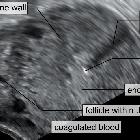Lithopädion






 nicht verwechseln mit: fetus in fetu
nicht verwechseln mit: fetus in fetuLithopaedions, also referred as stone babies, are a rare phenomenon which occurs most commonly when a fetus dies during an ectopic pregnancy.
Epidemiology
The estimated incidence is at ~ 1.5 to 1.8% of abdominal ectopic pregnancies .
Pathology
If the deceased fetus is too large to be re-absorbed by the mother’s body it becomes a foreign body to the mother’s immune system. To protect itself from possible infection, the mother’s body will encase the fetus in a calciferous substance. The fetus is gradually mummified becoming a stone baby. Lithopedions may occur from 14 weeks’ gestation to full term. It is not unusual for a stone baby to remain undiagnosed for decades and found incidentally when taking plain films for various reasons.
History and etymology
Derives from the Ancient Greek roots, litho (λίθο) = stone and paedion (παιδίον) = child.
Differential diagnosis
Diagnosis is usually straightforward, but differential hypotheses might include:
Siehe auch:

 Assoziationen und Differentialdiagnosen zu Lithopädion:
Assoziationen und Differentialdiagnosen zu Lithopädion:

